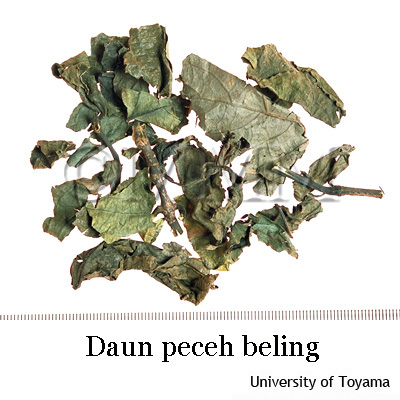Crude drug sample data base
※Click on the image to enlarge it.
Scientific information data base
| Crude drug name | Indonesian name, English name | Daun keji beling | ||||
|---|---|---|---|---|---|---|
| crude drug image |
| |||||
| Original plant name | Strobilanthes crispa Blume | |||||
| Family name | Acanthaceae | |||||
| Used part | Leaves | |||||
| Distribution area | It occurs wild in abandoned fields, on river banks in Java (Indonesia); sometimes it is planted in home gardens as a medicinal plant [201, 221]. | |||||
| Description | The leaves are opposite, oblong-lanceolate, 9-18 cm x 3-8 cm, decurrent at base, acuminate at apex, shallowly crenate-crispate, very scabrid. The plant is an erect herb up to 100 cm tall, branches are acutely quadrangular at top. Inflorescence a short and dense spike, corolla yellow; fruit fusiform [221]. | |||||
| Drug effect | Antioxidant [221]. | |||||
| Specific actions | Antidiabetes, treat kidney stones [201, 221, 231]. | |||||
| Frequency in use | Moderate. | |||||
| Common uses | Nowadays it is prepared as herbal tea and used as a diuretic [201, 221]. | |||||
| Pharmacological effect | A leaf infusion of S. crispus showed dissolving capacity on calcium stones [221]. The hot water extract of fermented and unfermented S. crispus tea reduced blood glucose in hyperglycaemic rats. The unfermented tea also reduced glucose level in normal rat. Both teas also showed to improve lipid profile. Antioxidant and polyphenol content that present in the extracts might contribute to the antihyperglycemic and antilipidemic properties [PMID: 16688478]. A study is conducted to investigate the components present in and the total antioxidant activity of leaves of S. crispus. The presence of high content of vitamin C, B1 and B2 contributed to the high antioxidant activity of the leaves. Catechins content showed highest antioxidant activity when compared to yerbamate and vitamin E [PMID: 11137889]. | |||||
| Medical system | Indonesian medicine (Jamu) | |||||
| Traditional usage | The leaves are popularly used to treat kidney stones and diabetes [201, 221]. | |||||
| Formulation | 1) Kidney stones: 1 gram of the leaves, 10 grams of Sonchus arvensis leaves are boiled with 100 ml of water. Stand to cool and strain. Drink 100 ml of the decoction once a day and repeat until the stones are expelled. It can also be prepared by pounding all ingredients to make a fine mixture, squeeze and drink 1/4 cup of the juice once a day. To avoid kidney stones formation, drink regularly decoction of Orthosiphon stamineus leaves [231]. | |||||
| References | Reference book Tips! | [201] K. Heyne, Tumbuhan Berguna Indonesia, Vols. 1-4, 1987. Diedarkan Oleh Koperasi Karyawan Departemen Kehutanan, Jakarta, Indonesia. Vol. 3, p 1754. [221] Lemmens, R.H.M.J. and Bunyapraphatsara, N. (editors): Plant Resources of South-East Asia No, 12 (3). Medicinal and poisonous plants 3. Prosea Foundation, Bogor, Indonesia. 2003. pp 385-387. [222] P.T. Eisai Indonesia: Medical Herb Index in Indonesia (Second edition).1995. p 251. [231] Soedibyo, Mooryati: Alam Sumber Kesehatan: Manfaat dan Kegunaan (Natural resources for health. Benefits and uses). Balai Pustaka. 1998. p 203. | ||||
| Research paper | 1. Fadzelly AB, Asmah R, Fauziah O. Effects of Strobilanthes crispus tea aqueous extracts on glucose and lipid profile in normal and streptozotocin-induced hyperglycemic rats. Plant Foods Hum Nutr. 61(1):7-12, 2006. (PMID: 16688478) 2. Ismail M, Manickam E, Danial AM, Rahmat A, Yahaya A. Chemical composition and antioxidant activity of Strobilanthes crispus leaf extract. J Nutr Biochem. 11(11-12):536-542, 2000. (PMID: 11137889) | |||||
| Remarks | Strobilanthes crispus has been used traditionally as antidiabetic, diuretic, antilytic, and laxative and has been proven scientifically to possess high antioxidant activity, anti-AIDS, and anticancer properties. It is commonly consumed in the form of herbal tea [PMID: 16688478]. A daily consumption of 5g/day of leaf extract as an herbal tea could contribute to the additional nutrients and antioxidants needed in the body [PMID: 11137889]. Recent findings also show that S. crispus may have prospects as a modern medicinal plant with stimulatory activity on the defense system of the body against diseases [221]. | |||||
| Last renewal date | 2024/03/04 | |||||





